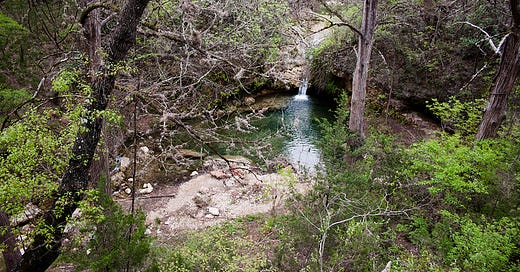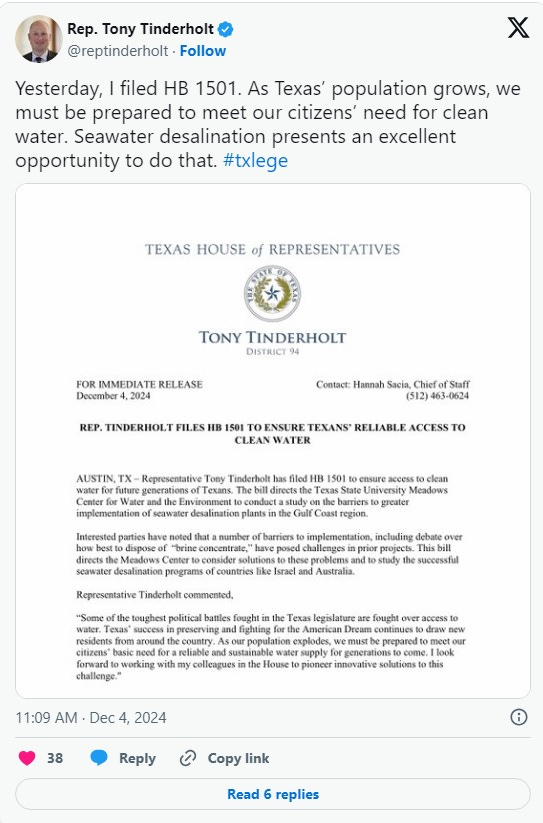Water, Water, (not) Everywhere...
Water infrastructure takes a front row seat in the Texas legislature this session.
It’s been a week and a half, hasn’t it? I’m doing my best not to bury my head in the sand but to well, maybe bury it mostly and keep one ear tilted up towards the sky to keep tabs on when the sky is going to imminently fall to the Earth. At this point I’m waiting for some Executive Order from our Petty Tyrant to come down declaring all species listed under the Endangered Species Act to suddenly not be endangered or threatened, and for all wetlands to have no protections, previous SCOTUS rulings be damned, no matter what pitiful arbiters of wetlands they may be.
Right now I’m trying to ride the waves, much as I did the first go ‘round, but these are much more forceful, much like the Gulf of Mexico during hurricane season. It’s harder to swim to shore now, and I’m not sure we won’t be trapped on the seafloor before all is said and done.
There are two things I’ve been tracking in my ads or suggested posts that show up on social media. One of them is new housing developments that show up mostly as a short article in the Houston Chronicle or in local business journals. The other has been discussions about water and water usage. I finally brought myself to start looking through the proposed bills for this legislative session in Texas a couple weeks ago and one of them stood out to me. We’re coming up on two years since the state fumbled and lost Fairfield Lake State Park, and knowing what we learned later during that effort to save the park—it was about the water—it isn’t a surprise that we’re back to talking about water access and its impacts with a growing population here in Texas.
HB 1501, submitted by Rep. Tony Tinderholt (R-Arlington), is a bill relating to studying the feasibility of seawater desalination in Texas. The bill means to have Texas State University’s Meadows Center for Water and the Environment to “…conduct a study evaluating the ways in which this state can incentivize the creation of seawater desalination plants along the Gulf Coast.”
I’ll admit, I don’t really know a lot about desalination plants or even what we have here in Texas. In my head I think desalination = seawater, but in reality, it is far broader than I even expected. The Texas Water Development Board filled in my gaps in knowledge, though. We have 53 municipal desalination facilities that have a total capacity of 157 million gallons per day. 16 of these are brackish surface water sources and 36 are brackish groundwater sources. A huge component of this is industrial desalination, which TWDB estimates to be 60-100 million gallons per day. The largest facility is located in El Paso, the Kay Bailey Hutchison desal plant which has been in operation since 2007.
As of now, we do not have any seawater desalination plants on the Texas Gulf Coast. However, Corpus Christi has been working on a plant for years and had hoped to have it open in 2023 but now it is looking to open in 2028. Even with this planned, the Texas Observer reported recently that the city of Corpus Christi is looking to lease land for wells that they can pump millions of gallons of water per day into the Nueces River, which is their main water supply. Their local reservoirs have lowered to below acceptable levels and years of drought and industrial use have taken a toll.
Meanwhile, the new industrial facilities have begun to draw water. An enormous plastics plant owned by ExxonMobil and Saudi Basic Industries Corp. uses millions of gallons per day. A lithium refinery owned by Tesla is slowly starting operations and plans to drastically increase its water consumption in coming years, according to water authority records. Another company has secured rights to millions of gallons per day of Nueces River water to produce hydrogen for export, but hasn’t yet broken ground. - Reservoirs Dwindle and Industrial Demand Grows by Dylan Baddour, Texas Observer
Texas may be open for business but we’re throwing our citizens and environment under the bus to do so.
“The majority of what are slated for our communities are large-volume water users,” said Elida Castillo, mayor pro-tem for the small city of Taft, which gets its water from Corpus Christi. “At the end of the day, they require tons of water that we do not have, and it’s all in the name of economic development.”
Meanwhile, Houston’s Mayor John Whitmire seems to be working with Governor Abbott to come up with a plan to sell Houston’s water to west Texas, despite our own water issues here in my neck of the woods. At least Galveston Bay Foundation’s Bob Stokes is speaking some sense here locally with his statement in that article: “To me this would be premature, before the city actually does some of their water planning, to commit to selling that water elsewhere.” Listen, I know we have our share of excess water on occasion (do I need to list every flood event?) but we need it for our estuaries and our own groundwater resources. In the rapidly developing Montgomery county, north of Houston, the city of Magnolia has issued moratoriums on development multiple times in the last couple of years due to water supply issues.
Rep. Tinderholt isn’t the only one on the desalination train, however. Senator Charles Perry, who is the chair of the Senate Committee on Water, Agriculture, and Rural Affairs (the same committee that killed the bill to save FLSP in spring 2023) is on a kick to dedicate funding to various water projects, much like a road infrastructure bill, for the 2025 legislative session. Senator Perry worked in the 2023 legislative session to pass the Texas Water Fund, which provided $1 billion in appropriation for water projects for the state. But Perry knows that more is needed to even accomplish what we’re facing, however he doesn’t seem to want to bother dealing first with addressing things like excessive pumping of groundwater or leaky pipes—just finding ways to get more water and then assessing the issues after.
“There’s no need to open up that can of worms politically and get into those weeds of how you’re gonna manage and what can we take more of and what can we take less of?” Perry said. “I’m going to fix the shortfall, and then we’ll have some conversations about, are we managing it better or worse?” - Lawmaker eyes desalination to help quench state’s thirst, Houston Chronicle
In addition to the desalination plants, Perry wants to fund pipeline projects to move the water around the state. Let me just say, this isn’t the first time these types of ideas have been proposed in the state. And I hope to have more essays about those in the coming weeks and months here.
As I’m writing this on January 29th, I’m seeing news about Lt. Gov Dan Patrick’s list of priorities for Senate bills and one of those is SB 7, to increase investments in water infrastructure. At this time, I am unable to pull up any SB 7 documentation via the lege’s bill lookup function so, stay tuned for that. But I suspect this is the same bill being promulgated by Senator Perry.
Elsewhere in the state, KUT reported a few days ago that the city of San Marcos is on track to run out of water by 2047 unless they plan now for continued growth. Currently the city had planned for only half of the proposed 303,000 residents by 2070, but to be honest that number seems like an underestimation of how many people will be in the area in 50 years. Meanwhile, the nearby city of Kyle is struggling with the same issues, as everyone on the I-35 corridor sucks the Edwards Aquifer dry. Further north on I-35, an article from February of 2024, also from KUT, warned that the city of Georgetown might not have enough water for everyone moving to town by 2030, six years from now. That seemed to have worried city officials enough that they’ve put together a news release to counteract those news articles, stating they had an Integrated Water Resource Plan, developed in 2023, to deal with upcoming water issues. However, it looks like that plan really only gets them to 2050. The one thing you’ll notice between a lot of these articles is how many are tied to obtaining water from the Carrizo-Wilcox Aquifer, an aquifer that runs from the Pineywoods southwest to the portions of the Rio Grande at the border. Fairfield Lake and its deep water wells are in that same aquifer.
In all of this, I think what should be highlighted is how much industry is sucking our water resources dry. It goes beyond homeowners installing low flow toilets or watering lawns at certain times of the year. The amount of water needed to cool vast data centers for AI or bitcoin mining is exceptional, and honestly, glossed over by most, and especially elected officials wanting business in the state and campaign contributions. I think all of that deserves its own look and that’s another one I’ll come back to this spring.
And while this has been a central/coastal Texas focused topic today, I’d be remiss not to bring up the proposed and contentious Marvin Nichols Reservoir northeast of Dallas. If you haven’t been around DFW lately, its sprawl is as bad as central Texas, with the suburbs quickly approaching the Oklahoma border. Do we drown bottomlands on the Sulphur River to keep supplying water for lawns for DFW residents?
When we moved back to Texas in 2010 there was a brief period of time that I thought moving to the Austin area would be a fun idea. I still do think that when I get into that vast, limestone landscape west of the sprawl. But then I think about the lack of rainfall, the constant droughts, and the pressure I’d be adding to an already taxed ecosystem and am glad we didn’t move there. That said, east Texas is starting to feel these effects, too. Unrelenting growth isn’t sustainable. Senator Perry trying to pretend water isn’t political just to keep donors happy isn’t the ethical way to approach the situation either. The truth is, it isn’t going to be pretty here in 20 years, especially 50 years. Maybe sooner. Unfortunately we’re really just putting a Band-Aid over the wound and not pumping the antibiotics needed to treat the infection. And so it will continue to fester until it’s time to amputate.
With throats unslaked, with black lips baked,
We could nor laugh nor wail;
Through utter drought all dumb we stood!
I bit my arm, I sucked the blood,
And cried, A sail! a sail!
-The Rime of the Ancient Mariner by Samuel Taylor Coleridge







I am consummately grateful to you for keeping an ear and eye out for what's happening environmentally in Texas & across the U.S. Thank you for your service, Misti.
Thanks so much for this reporting. As long as Texas keeps voting in corrupt rich people and declaring that supercharged growth is essential, I see little hope. People like Tinderholt (my rep😖) will make poor people pay for expensive projects but still let us run out of water.